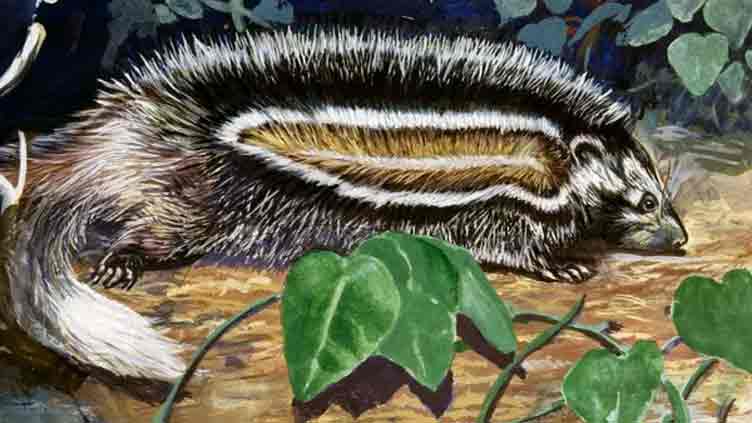World's deadliest rat, which can kill an elephant with one bite

WeirdNews
World's deadliest rat, which can kill an elephant with one bite
(Web Desk) - Did you know there's a rat poisonous enough to kill an elephant?
Lophiomys imhausi, also known as the crested rat, the maned rat, and the African crested rat, is a deadly rarity says Aoife Glass.
The crested rat is the only known poisonous rodent, and the only known mammal to sequester plant toxins for use as a defense mechanism. One bite is enough to kill.
What does the crested rat look like?
Adult crested rats grow to between 360mm and 530mm head to tail. The small head is covered in short, black fur, while the body and tail have a thick grey and white undercoat with longer guard hairs tipped white or black, together giving the impression of a small, fluffy skunk.
What's the biggest rat in the world?
A mane of longer black and white banded hairs stretches the length of the rat from the head to the base of the tail, and this is the crest or mane from which the animal gets its name. When it’s threatened, this mane erects, exposing a band down each side of the body, bordered in white, with specially adapted hairs covering glandular skin.
This has two purposes. The first, like a skunk, is to display warning colouration. The second is to reveal those specially adapted hairs, which contain enough toxin to make any animal that decides to take a bite extremely ill, if not fatally poisoned.
Why are nature's deadliest poisons so lethal? We explain the difference between venoms and toxins - and why some are so severe they kill
Where does the crested rat live?
Sometimes called the African crested rat, this species lives in forests, savannah and shrubland, favouring rocky terrain, and nesting in hollow tree trunks, holes and hollows. Populations have been observed in Somalia, Ethiopia, Sudan, United Republic of Tanzania, Keny, Djibouti and Eritrea.
Crested rats seem to be mostly solitary, sometimes living within a small family group of male, female and offspring. Female crested rats have small litters of between one to three offspring.
What does the crested rat eat?
Despite its fearsome reputation, the crested rat’s diet of choice mostly consists of plant material such as leaves and fruit, though it has been known to eat meat, insects and root vegetables.
Unusually, it has stomach physiology that’s similar to ruminants such as cattle; a four-chambered stomach with plenty of digesting bacteria which allows it to process and breakdown the food it consumes. This fact makes it unique amongst Moroidea, the super family to which all rodents belong.
Why is the crested rat so deadly?
The other unique element of the crested rat is its killer abilities. It’s the only known rodent that uses toxins from another species as a defence mechanism, and it does this via some incredible evolutionary adaptations.
These toxic and highly poisonous crabs are capable of killing a human with just tiny amount of toxin - and there's no antidote! First, Lophiomys imhausi feeds on the bark of the African poison arrow tree, Acokanthera schimperi. The bark, as well as the roots, stems, leaves and seeds of this tree, contain acovenoside A and ouabaine; these are heart stimulating chemicals, called cardenolides. In small doses, these types of chemicals can be used for medicinal purposes, but at larger doses can have catastrophic effects; vomiting, convultions, breathing difficulties and even cardiac arrest.
Next, L. imhausi licks the hairs along the glandular skill patches either side of its crest, depositing saliva infused with those cardiotonic glycosides from the African poison arrow tree. At a glance, these hairs look much like those on other areas of the crested rat, but they have a very particular structure; a honey-comb outer layer, with an inner layer of long vertical fibres. This makes them particularly suited to absorbing liquid, dispersing it along its interior, and storing or ‘sequestering’ it.
How does the crested rat kill?
If a would-be predator ignores the warning colouration and tries to attack, the exposed hairs will release these toxic compounds into the mouth, and very quickly into the bloodstream. With natural predators including the honey badger, caracal, serval, hyena and leopard, an effective deterrent is a definite evolutionary advantage.
Just how toxic could the crested rat be?
Arrows treated with the same cardenolide toxins have floored full-grown elephants, so potentially very deadly indeed. However, it’s not in the rat’s interest to kill every predator that attacks; instead, it ideally needs to make them so poorly that they learn that crested rats aren’t on the menu in the future.
Casualties do happen though, and dogs that have attacked crested rats have been known to die; those lucky enough to survive display, unsurprisingly, a strong fear response at any future encounters.
The crested rat also has a particularly thick dermis or skin, making it very resistant to bites, and a very long, strong and flexible spine with four extra vertebrae.



